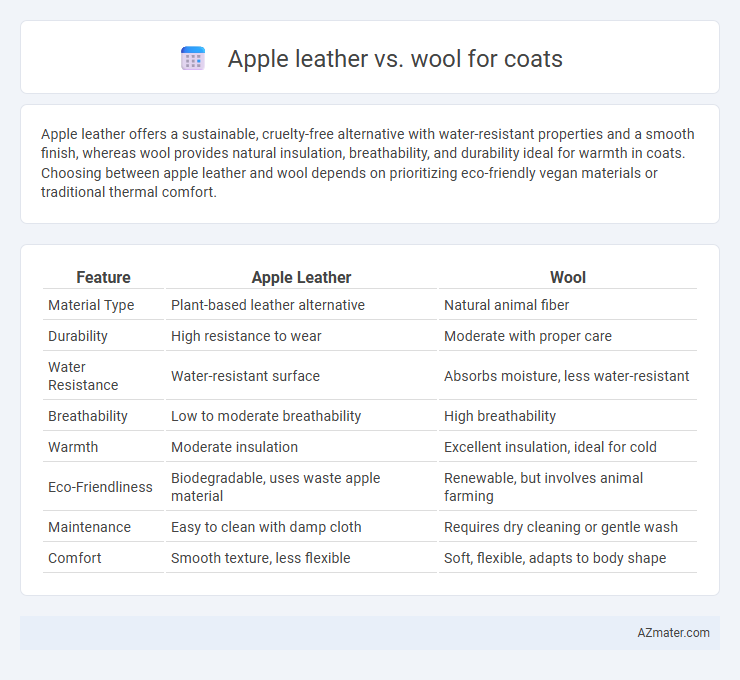Apple leather offers a sustainable, cruelty-free alternative with water-resistant properties and a smooth finish, whereas wool provides natural insulation, breathability, and durability ideal for warmth in coats. Choosing between apple leather and wool depends on prioritizing eco-friendly vegan materials or traditional thermal comfort.
Table of Comparison
| Feature | Apple Leather | Wool |
|---|---|---|
| Material Type | Plant-based leather alternative | Natural animal fiber |
| Durability | High resistance to wear | Moderate with proper care |
| Water Resistance | Water-resistant surface | Absorbs moisture, less water-resistant |
| Breathability | Low to moderate breathability | High breathability |
| Warmth | Moderate insulation | Excellent insulation, ideal for cold |
| Eco-Friendliness | Biodegradable, uses waste apple material | Renewable, but involves animal farming |
| Maintenance | Easy to clean with damp cloth | Requires dry cleaning or gentle wash |
| Comfort | Smooth texture, less flexible | Soft, flexible, adapts to body shape |
Overview of Apple Leather and Wool for Coats
Apple leather, a sustainable alternative made from apple waste, offers a cruelty-free, eco-friendly option with a smooth, leather-like texture ideal for stylish, lightweight coats. Wool, a traditional natural fiber, provides superior warmth, breathability, and moisture-wicking properties, making it a durable choice for cold-weather outerwear. While apple leather excels in vegan fashion and maintenance ease, wool remains unmatched for insulation and long-lasting comfort in coat construction.
Sustainability and Environmental Impact
Apple leather, derived from apple waste, offers a sustainable alternative to traditional leather by reducing agricultural waste and lowering carbon emissions during production, making it an eco-friendly choice for coat materials. Wool, as a natural fiber, is renewable and biodegradable but involves higher water usage, methane emissions from sheep, and land consumption that impact its environmental footprint. Choosing apple leather over wool for coats supports circular fashion principles, minimizes resource-intensive processes, and promotes reduced greenhouse gas output.
Durability and Longevity
Apple leather offers superior durability compared to traditional wool, as it resists water and stains while maintaining structural integrity over time. Wool is naturally resilient and breathable but may experience pilling, shrinking, or wear, especially with frequent use and exposure to moisture. Apple leather's synthetic nature enhances longevity by preventing common wool degradation issues, making it a more long-lasting option for coat materials.
Comfort and Breathability
Apple leather offers a soft, flexible texture that mimics natural leather while enhancing comfort through its lightweight and breathable properties. Wool provides superior insulation and moisture-wicking capabilities, maintaining warmth without sacrificing breathability, making it ideal for varying climates. Both materials balance comfort and airflow, but wool excels in temperature regulation, whereas apple leather offers a smoother, vegan-friendly option.
Insulation and Warmth
Apple leather offers limited insulation and is less effective in retaining warmth compared to wool, making it less suitable for cold weather coats. Wool fibers provide superior thermal insulation by trapping air and maintaining body heat, ensuring optimal warmth in chilly conditions. For coats prioritizing insulation and warmth, wool remains the preferred material due to its natural heat retention and breathability.
Style and Aesthetic Appeal
Apple leather offers a sleek, modern look with a smooth texture that enhances contemporary coat designs, often appealing to eco-conscious fashion enthusiasts. Wool provides a classic, timeless aesthetic with its rich texture and natural warmth, ideal for traditional and high-end outerwear styles. Both materials contribute distinct visual and tactile qualities, with apple leather emphasizing innovation and sustainability, while wool ensures enduring elegance and comfort.
Maintenance and Care Requirements
Apple leather coats require minimal maintenance, needing only occasional wiping with a damp cloth to remove dirt and prevent cracking, while avoiding direct heat and prolonged sun exposure to maintain their texture. Wool coats demand more attention through regular brushing to remove surface dirt, and periodic dry cleaning to preserve fiber quality and shape. Proper storage for both materials involves a cool, dry environment with breathable garment bags to prevent mold and maintain longevity.
Allergen and Sensitivity Considerations
Apple leather, a hypoallergenic and cruelty-free alternative made from apple waste, is less likely to irritate sensitive skin due to its synthetic and natural blend. Wool coats, while natural and warm, can trigger allergies or skin irritation in individuals sensitive to lanolin or wool fibers. Choosing apple leather offers a smoother texture with fewer allergenic proteins, beneficial for those with heightened skin sensitivities or respiratory concerns.
Ethical and Animal Welfare Factors
Apple leather offers a sustainable alternative to traditional animal-based materials by utilizing apple waste, significantly reducing environmental impact and preventing animal harm. Wool production involves animal farming, raising concerns about animal welfare practices such as shearing and living conditions, which vary widely by source and certification. Choosing apple leather aligns with cruelty-free principles and supports circular fashion, while wool's ethical standing depends heavily on responsible sourcing and animal welfare standards.
Price Comparison and Value
Apple leather coats generally offer a more affordable price point compared to wool coats, making them a cost-effective option for eco-conscious consumers. Wool coats, while more expensive, provide superior insulation and durability, often resulting in better long-term value despite the higher initial investment. Buying decisions should consider both upfront cost and the lifespan of the material to maximize overall value.

Infographic: Apple leather vs Wool for Coat
 azmater.com
azmater.com